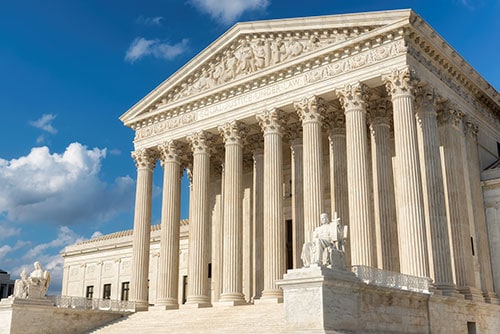Unfair and Unjust Practices and Conditions Harm People with Behavioral Health Conditions and Drive Health Disparities
People with behavioral health conditions are subject to more negative judgements and stigmatization than people with physical health conditions.15
People with behavioral health conditions have also been harmed by unjust practices related to the sale of commercial tobacco*.5
Tobacco companies funded research to support ideas that have been proven to be untrue, including the hypothesis that people with schizophrenia could not develop lung cancer, and the idea that people with mental health conditions need cigarettes to treat their symptoms.16 Tobacco industry lobbyists have cited this disproven research to resist efforts to promote smokefree policies in psychiatric hospitals.17 Misperceptions that smoking could alleviate symptoms of mental health conditions may affect mental health providers’ willingness to offer smoking cessation treatments to people with behavioral health conditions.18
Tobacco companies have created marketing plans that target population groups, including people who use illicit substances. One example was “Project SCUM” (Sub-Culture Urban Marketing), a 1990’s marketing strategy that attempted to co-brand tobacco as part of drug culture through product placement in shops that sold related paraphernalia.17
People with behavioral health conditions have also experienced discrimination and harm from systems meant to protect and improve health and well-being, including health care and medical science.
-
- Until the passage of the Education for All Handicapped Children Act in 1975 it was legal to exclude children with behavioral health conditions from schools. Before the passage of the law, Congress found that four million children with disabilities were either excluded from public school services or served inappropriately.19
- The Americans with Disabilities Act – passed in 1990 – did not fully or evenly protect people with behavioral health conditions from workplace discrimination until clarifications were adopted in 2008.19,20
- Health insurance coverage for behavioral health conditions has historically been less generous than coverage for medical care. Protections have expanded over time, starting with the Mental Health Parity Act of 1996 and the Mental Health Parity and Addiction Equity Act of 2008. There was no requirement that all insurance plans cover behavioral health conditions until the Patient Protection and Affordable Care Act of 2010.19,21
There are also current reasons—like the ones explored below—that help explain why commercial tobacco affects the health of people with behavioral health conditions.
Marketing plays a big role in whether people try or use commercial tobacco products. Commercial tobacco ads make smoking seem more appealing and increase the chance that someone will try smoking for the first time or start using commercial tobacco products regularly.22,23,24,25
Tobacco companies spend billions of dollars each year to aggressively market their products. They also target specific populations, including people who have behavioral health conditions, with commercial tobacco advertising.17 For example:
-

Tobacco companies market and advertise tobacco products to people with behavioral health conditions.
- Advertisements for commercial tobacco products often incorporate images of carefree people who are smoking, socially engaged, and with freedom from stress and anxieties.17
- In one study of a large, metropolitan area, people who had a serious mental health condition were twice as likely as those without a serious mental health condition to live in a neighborhood with more tobacco retailers and more advertisements for commercial tobacco product.26
- Commercial tobacco brands use donations to civic groups as a way of generating influence and bolstering their public image. The industry has a history of making financial contributions to organizations that work with people with behavioral health conditions and have given free or discounted cigarettes to psychiatric facilities.16,17
To help protect people with behavioral health conditions from tobacco marketing and discourage tobacco use, states and communities could consider increasing prices and prohibiting price discounts, prohibiting the sale of flavored tobacco products, and either allowing fewer stores in a neighborhood to sell commercial tobacco products or prohibiting tobacco product sales altogether.27
- Substance Abuse and Mental Health Services Administration. Results from the 2016 National Survey on Drug Use and Health: Detailed Tables. Rockville, MD: Substance Abuse and Mental Health Services Administration, Center for Behavioral Health Statistics and Quality, 2017 [accessed 2022 Feb 25].
- Center for Behavioral Health Statistics and Quality. (2020). Results from the 2019 National Survey on Drug Use and Health: Detailed tables. Rockville, MD: Substance Abuse and Mental Health Services Administration [accessed 2022 Feb 25].
- Druss BG, Zhao L, Von Esenwein S, Morrato EH, Marcus SC. Understanding Excess Mortality in Persons With Mental Illness: 17-Year Follow Up of a Nationally Representative US Survey. Medical Care 2011;49(6):599–604 [accessed 2022 Feb 25].
- Schroeder S A, Morris CD. Confronting a neglected epidemic: tobacco cessation for persons with mental illnesses and substance abuse problems. Annual Review of Public Health, 2010;31:297–314 [accessed 2022 Feb 25].
- Richter KP, Arnsten JH. A rationale and model for addressing tobacco dependence in substance abuse treatment. Substance Abuse Treatment, Prevention, and Policy. 2006;1(1):23 [accessed 2022 Feb 25].
- Tam J, Warner KE, Meza R. Smoking and the reduced life expectancy of individuals with serious mental illness. American Journal of Preventive Medicine. 2016; 51(6):958–966 [accessed 2022 Feb 25].
- Apollonio DE, Malone RE. Marketing to the marginalised: tobacco industry targeting of the homeless and mentally ill. Tob Control. 2005;14(6):409-415 [accessed 2022 Feb 25].
- Campbell BK, Le T, Andrews KB, Pramod S, Guydish J. Smoking among patients in substance use disorders treatment: associations with tobacco advertising, anti-tobacco messages, and perceived health risks. Am J Drug Alcohol Abuse. 2016;42(6):649-656 [accessed 2022 Feb 25].
- Marynak K, Vanfrank B, Tetlow S, et al. Tobacco Cessation Interventions and Smoke-Free Policies in Mental Health and Substance Abuse Treatment Facilities—United States, 2016. Morbidity and Mortality Weekly Report, 2018;67(18):519-23 [accessed 2022 Feb 25].
- Jamal A, Phillips E, Gentzke AS, et al. Current Cigarette Smoking Among Adults - United States, 2016. MMWR Morb Mortal Wkly Rep. 2018;67(2):53-59 [accessed 2022 Feb 25].
- Cook BL, Wayne GF, Kafali EN, Liu Z, Shu C, Flores M. Trends in Smoking Among Adults With Mental Illness and Association Between Mental Health Treatment and Smoking Cessation. JAMA. 2014;311(2):172–182 [accessed 2022 Feb 25].
- Dickerson F, Schroeder J, Katsafanas E, et al. Cigarette Smoking by Patients With Serious Mental Illness, 1999-2016: An Increasing Disparity. Psychiatr Serv. 2018;69(2):147-153 [accessed 2022 Feb 25].
- Young-Wolff KC, Hickman NJ 3rd, Kim R, Gali K, Prochaska JJ. Correlates and prevalence of menthol cigarette use among adults with serious mental illness. Nicotine Tob Res. 2015;17(3):285-291 [accessed 2022 Feb 25].
- NIH State‐of‐the‐Science Panel. National Institutes of Health State‐of‐the‐Science conference statement: tobacco use: prevention, cessation, and control. Ann Intern Med. 2006;145:839‐844 [accessed 2022 Feb 25].
- Centers for Disease Control and Prevention, Substance Abuse and Mental Health Services Administration, National Association of County Behavioral Health & Developmental Disability Directors, National Institute of Mental Health, The Carter Center Mental Health Program. Attitudes Toward Mental Illness: Results from the Behavioral Risk Factor Surveillance System. Atlanta (GA); Centers for Disease Control and Prevention; 2012 [accessed 2022 Feb 25].
- Prochaska JJ, Hall SM, Bero LA. Tobacco use among individuals with schizophrenia: What role has the tobacco industry played? Schizophr. Bull. 2008;34:555–67 [accessed 2022 Feb 25].
- Prochaska JJ, Smita D, Young-Wolff KC. Smoking, mental illness, and public health. Annual Review of Public Health. 2017; 38: 165-185[accessed 2022 Feb 25].
- Lawn S, Pols R. Smoking bans in psychiatric inpatient settings? A review of the research. Aust. N. Z. J. Psychiatry. 2005;39:866–85[accessed 2022 Feb 25].
- Cummings JR et al. Addressing public stigma and disparities among persons with mental illness: the role of federal policy. American Journal of Public Health. 2013;103(5): 781-5 [accessed 2022 Feb 25].
- Americans with Disabilities Act of 1990, Pub. L. No. 101-336, 104 Stat. 327 [accessed 2022 Feb 25].
- Patient Protection and Affordable Care Act, 2010, Pub. L. No. 111-148, 124 Stat. 119 [accessed 2022 Feb 25].
- Carson NJ, Rodriguez D, Audrain-McGovern J. Investigation of mechanisms linking media exposure to smoking in high school students. Prev Med. 2005;41(2): 511-20 [accessed 2022 Feb 25].
- Charlesworth A, Glantz SA. Smoking in the movies increases adolescent smoking: A review. Pediatrics 2005;116(6): 1516-28 [accessed 2022 Feb 25].
- U.S. Department of Health and Human Services. The Health Consequences of Smoking: 50 Years of Progress. A Report of the Surgeon General. Atlanta, GA: U.S. Department of Health and Human Services, Centers for Disease Control and Prevention, National Center for Chronic Disease Prevention and Health Promotion, Office on Smoking and Health, 2014 [accessed 2022 Apr 28].
- National Cancer Institute. The Role of the Media in Promoting and Reducing Tobacco Use. Tobacco Control Monograph No. 19. Bethesda, MD: U.S. Department of Health and Human Services, National Institutes of Health, National Cancer Institute. NIH Pub. No. 07-6242, June 2008 [accessed 2022 Apr 28].
- Young-Wolff KC, Henriksen L, Delucchi K, Prochaska JJ. Tobacco retailer proximity and density and nicotine dependence among smokers with serious mental illness. Am J Public Health. 2014;104(8):1454-1463 [accessed 2022 Feb 25].
- Robertson L, McGee R, Marsh L, Hoek, J. A systematic review on the impact of point-of-sale tobacco promotion on smoking. Nicotine & Tobacco Research. 2015;17(1): 2-17 [accessed 2022 Feb 25].
- Centers for Disease Control and Prevention. Vital Signs: Current Cigarette Smoking Among Adults Aged ≥18 Years With Mental Illness—United States, 2009–2011. Morbidity and Mortality Weekly Report 2013;62(5):81-7 [accessed 2022 Feb 25].
- Lohr JB, Flynn K. Smoking and schizophrenia. Schizophr Res. 1992;8(2):93-102 [accessed 2022 Feb 25].
- Prochaska JJ. Smoking and Mental Illness—Breaking the Link. New England Journal of Medicine, 2011;365:196-8 [accessed 2022 Feb 25].
- McEwen BS. Stress, adaptation, and disease. Allostasis and allostatic load. Ann N Y Acad Sci. 1998;840:33-44 [accessed 2022 Feb 25].
- Slopen N, Dutra LM, Williams DR, et al. Psychosocial stressors and cigarette smoking among African American adults in midlife. Nicotine Tob Res. 2012;14(10):1161-1169 [accessed 2022 Feb 25].
- Weinberger AH, Gbedemah M, Wall MM, Hasin DS, Zvolensky MJ, Goodwin RD. Cigarette use is increasing among people with illicit substance use disorders in the United States, 2002-14: emerging disparities in vulnerable populations. Addiction. 2018;113(4):719-728 [accessed 2022 Feb 25].
- Prochaska JJ, Delucchi K, Hall SM. A meta-analysis of smoking cessation interventions with individuals in substance abuse treatment or recovery. Journal of Consulting and Clinical Psychology. 2004;72(6), 1144 [accessed 2022 Feb 25].
- Compton W. The need to incorporate smoking cessation into behavioral health treatment. The American Journal on Addictions. 2018; 27(1):42–43 [accessed 2022 Feb 25].
- Taylor G, McNeill A, Girling A, Farley A, Lindson-Hawley N, Aveyard P. Change in mental health after smoking cessation: systematic review and meta-analysis. BMJ. 2014; 348:1151. [accessed 2022 Feb 25].
- Vital Signs: Adult Smoking Focusing on People with Mental Illness [PDF - 3.2 MB], February 2013 [accessed 2022 Feb 25].
- Substance Abuse and Mental Health Services Administration, Center for Behavioral Health Statistics and Quality. The N-SSATS Report: Tobacco Cessation Services. September 19, 2013. Rockville, MD [accessed 2022 Feb 25].
- Brown, CH et al. Factors influencing implementation of smoking cessation treatment within community mental health centers. Journal of Dual Diagnosis. 2015;11(2): 145-50 [accessed 2022 Feb 25].
- DiGiulio A, Jump Z, Babb S, et al. State Medicaid Coverage for Tobacco Cessation Treatments and Barriers to Accessing Treatments — United States, 2008–2018. MMWR Morb Mortal Wkly Rep 2020;69:155–160 [accessed 2022 Feb 25].
- Smoking Cessation Leadership Center. Fact Sheet: The Tobacco Epidemic Among People With Behavioral Health Disorders. San Francisco: Smoking Cessation Leadership Center, University of California, 2015 [accessed 2022 Feb 25].
- U.S. Department of Health and Human Services. Smoking Cessation. A Report of the Surgeon General. [PDF - 10 MB] Atlanta, GA: U.S. Department of Health and Human Services, Centers for Disease Control and Prevention, National Center for Chronic Disease Prevention and Health Promotion, Office on Smoking and Health, 2020 [accessed 2022 Feb 25].
- Davis KC, Duke J, Shafer P, Patel D, Rodes R, & Beistle D Perceived effectiveness of antismoking ads and association with quit attempts among smokers: evidence from the Tips from Former Smokers campaign. Health Communication. 2017; 32(8), 931-938 [accessed 2022 Feb 25].




